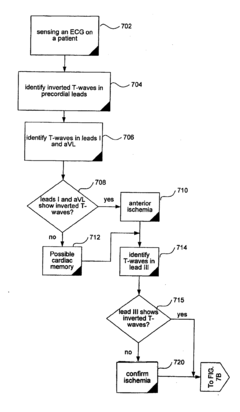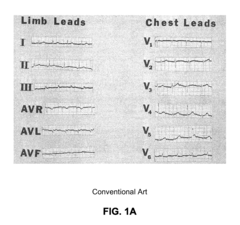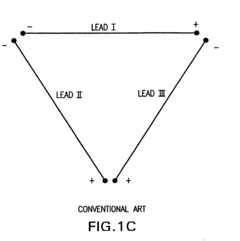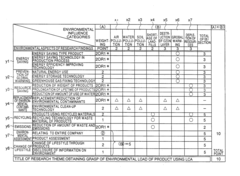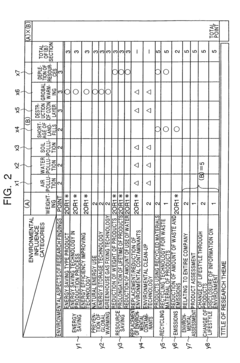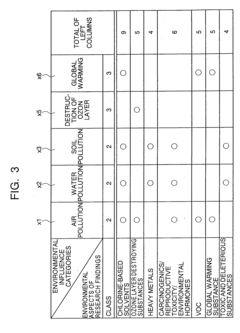T wave inversion analysis in the context of environmental stress factors
AUG 19, 20259 MIN READ
Generate Your Research Report Instantly with AI Agent
Patsnap Eureka helps you evaluate technical feasibility & market potential.
T Wave Inversion Background and Objectives
T wave inversion is a significant electrocardiographic finding that has long been associated with various cardiac conditions. However, recent research has shed light on its potential relationship with environmental stress factors, opening up new avenues for investigation and clinical application. This technological exploration aims to comprehensively examine the historical development of T wave inversion analysis, its current state, and the emerging trends in the context of environmental stressors.
The study of T wave inversion dates back to the early 20th century when electrocardiography was first introduced as a diagnostic tool. Initially, T wave inversion was primarily linked to myocardial ischemia and infarction. Over the decades, our understanding of this phenomenon has evolved, recognizing its presence in a broader spectrum of cardiac and non-cardiac conditions.
In recent years, there has been a growing interest in exploring the influence of environmental factors on cardiovascular health. This shift in focus has led researchers to investigate the potential correlation between T wave inversion and various environmental stressors, such as air pollution, extreme temperatures, and high-altitude exposure. The objective of this technological assessment is to evaluate the current state of knowledge regarding T wave inversion analysis in the context of these environmental stress factors.
One of the primary goals of this exploration is to identify and analyze the latest advancements in ECG technology and data analysis techniques that enable more accurate detection and interpretation of T wave inversions. This includes examining novel algorithms, machine learning approaches, and high-resolution ECG systems that can potentially enhance our ability to discern environmentally induced T wave changes from those caused by underlying cardiac pathologies.
Furthermore, this technological assessment aims to explore the potential applications of T wave inversion analysis in environmental health monitoring and risk assessment. By understanding the relationship between environmental stressors and T wave morphology, we may be able to develop early warning systems for environmental health hazards or create personalized risk profiles for individuals exposed to specific environmental conditions.
Another crucial objective is to evaluate the challenges and limitations of current T wave inversion analysis methods in the context of environmental stress factors. This includes addressing issues such as signal noise, inter-individual variability, and the complex interplay between multiple environmental stressors. By identifying these challenges, we can better direct future research efforts and technological developments in this field.
Lastly, this exploration seeks to outline potential future directions for T wave inversion analysis, particularly in the realm of wearable technology and continuous monitoring. As the Internet of Things (IoT) and mobile health technologies continue to advance, there is an opportunity to integrate T wave inversion analysis into personal health monitoring devices, potentially revolutionizing our approach to environmental health surveillance and personalized medicine.
The study of T wave inversion dates back to the early 20th century when electrocardiography was first introduced as a diagnostic tool. Initially, T wave inversion was primarily linked to myocardial ischemia and infarction. Over the decades, our understanding of this phenomenon has evolved, recognizing its presence in a broader spectrum of cardiac and non-cardiac conditions.
In recent years, there has been a growing interest in exploring the influence of environmental factors on cardiovascular health. This shift in focus has led researchers to investigate the potential correlation between T wave inversion and various environmental stressors, such as air pollution, extreme temperatures, and high-altitude exposure. The objective of this technological assessment is to evaluate the current state of knowledge regarding T wave inversion analysis in the context of these environmental stress factors.
One of the primary goals of this exploration is to identify and analyze the latest advancements in ECG technology and data analysis techniques that enable more accurate detection and interpretation of T wave inversions. This includes examining novel algorithms, machine learning approaches, and high-resolution ECG systems that can potentially enhance our ability to discern environmentally induced T wave changes from those caused by underlying cardiac pathologies.
Furthermore, this technological assessment aims to explore the potential applications of T wave inversion analysis in environmental health monitoring and risk assessment. By understanding the relationship between environmental stressors and T wave morphology, we may be able to develop early warning systems for environmental health hazards or create personalized risk profiles for individuals exposed to specific environmental conditions.
Another crucial objective is to evaluate the challenges and limitations of current T wave inversion analysis methods in the context of environmental stress factors. This includes addressing issues such as signal noise, inter-individual variability, and the complex interplay between multiple environmental stressors. By identifying these challenges, we can better direct future research efforts and technological developments in this field.
Lastly, this exploration seeks to outline potential future directions for T wave inversion analysis, particularly in the realm of wearable technology and continuous monitoring. As the Internet of Things (IoT) and mobile health technologies continue to advance, there is an opportunity to integrate T wave inversion analysis into personal health monitoring devices, potentially revolutionizing our approach to environmental health surveillance and personalized medicine.
Market Need for Environmental Stress ECG Analysis
The market for environmental stress ECG analysis is experiencing significant growth, driven by the increasing recognition of the impact of environmental factors on cardiovascular health. As urbanization and industrialization continue to accelerate globally, populations are increasingly exposed to various environmental stressors, including air pollution, noise pollution, extreme temperatures, and electromagnetic fields. These factors have been linked to a higher incidence of cardiovascular diseases, creating a pressing need for advanced diagnostic tools that can detect early signs of cardiac stress.
The healthcare industry is witnessing a shift towards preventive care and personalized medicine, which has further fueled the demand for sophisticated ECG analysis techniques. Environmental stress ECG analysis offers a unique opportunity to identify subtle changes in cardiac function before they manifest as clinical symptoms. This proactive approach aligns with the goals of healthcare systems worldwide to reduce the burden of cardiovascular diseases and improve patient outcomes.
In the occupational health sector, there is a growing emphasis on monitoring the health of workers exposed to challenging environmental conditions. Industries such as construction, mining, and manufacturing are increasingly investing in technologies that can assess the impact of workplace environmental factors on employee health. Environmental stress ECG analysis provides a valuable tool for occupational health professionals to monitor cardiac health and implement targeted interventions to mitigate risks.
The wearable technology market has also contributed to the rising demand for environmental stress ECG analysis. Consumer interest in health tracking devices has surged, with many individuals seeking to understand how their surroundings affect their cardiovascular health. This trend has created opportunities for the development of consumer-grade ECG devices capable of detecting T wave inversions and other stress-related cardiac changes in real-time.
Research institutions and pharmaceutical companies are showing increased interest in environmental stress ECG analysis for clinical trials and drug development. The ability to accurately assess the cardiac effects of environmental stressors can provide valuable insights into the safety and efficacy of new medications, particularly those targeting cardiovascular conditions.
As climate change continues to impact global weather patterns, there is a growing need to understand how extreme environmental conditions affect cardiovascular health. Environmental stress ECG analysis can play a crucial role in studying the physiological responses to heat waves, cold snaps, and other climate-related phenomena, informing public health strategies and adaptation measures.
The market for environmental stress ECG analysis is expected to expand further as advancements in artificial intelligence and machine learning enhance the accuracy and interpretability of ECG data. These technologies promise to improve the detection of subtle T wave inversions and other stress-related ECG changes, making environmental stress analysis more accessible and reliable for healthcare providers and researchers alike.
The healthcare industry is witnessing a shift towards preventive care and personalized medicine, which has further fueled the demand for sophisticated ECG analysis techniques. Environmental stress ECG analysis offers a unique opportunity to identify subtle changes in cardiac function before they manifest as clinical symptoms. This proactive approach aligns with the goals of healthcare systems worldwide to reduce the burden of cardiovascular diseases and improve patient outcomes.
In the occupational health sector, there is a growing emphasis on monitoring the health of workers exposed to challenging environmental conditions. Industries such as construction, mining, and manufacturing are increasingly investing in technologies that can assess the impact of workplace environmental factors on employee health. Environmental stress ECG analysis provides a valuable tool for occupational health professionals to monitor cardiac health and implement targeted interventions to mitigate risks.
The wearable technology market has also contributed to the rising demand for environmental stress ECG analysis. Consumer interest in health tracking devices has surged, with many individuals seeking to understand how their surroundings affect their cardiovascular health. This trend has created opportunities for the development of consumer-grade ECG devices capable of detecting T wave inversions and other stress-related cardiac changes in real-time.
Research institutions and pharmaceutical companies are showing increased interest in environmental stress ECG analysis for clinical trials and drug development. The ability to accurately assess the cardiac effects of environmental stressors can provide valuable insights into the safety and efficacy of new medications, particularly those targeting cardiovascular conditions.
As climate change continues to impact global weather patterns, there is a growing need to understand how extreme environmental conditions affect cardiovascular health. Environmental stress ECG analysis can play a crucial role in studying the physiological responses to heat waves, cold snaps, and other climate-related phenomena, informing public health strategies and adaptation measures.
The market for environmental stress ECG analysis is expected to expand further as advancements in artificial intelligence and machine learning enhance the accuracy and interpretability of ECG data. These technologies promise to improve the detection of subtle T wave inversions and other stress-related ECG changes, making environmental stress analysis more accessible and reliable for healthcare providers and researchers alike.
Current Challenges in T Wave Inversion Detection
T wave inversion detection in electrocardiograms (ECGs) faces several significant challenges, particularly when considering environmental stress factors. One of the primary difficulties lies in distinguishing between pathological T wave inversions and those induced by environmental stressors, such as extreme temperatures, high altitude, or physical exertion.
The variability in T wave morphology across different individuals and even within the same individual under different conditions complicates the detection process. Environmental factors can cause transient changes in T wave polarity and amplitude, making it challenging to establish consistent detection criteria. This variability necessitates the development of adaptive algorithms capable of accounting for these dynamic changes.
Another major challenge is the presence of noise and artifacts in ECG signals, which can be exacerbated by environmental factors. Motion artifacts, electromagnetic interference, and poor electrode contact due to sweating or movement can all contribute to signal distortion, potentially masking or mimicking T wave inversions. Developing robust signal processing techniques to filter out these artifacts without losing critical T wave information remains an ongoing challenge.
The influence of autonomic nervous system activity on T wave morphology presents another layer of complexity. Environmental stressors can trigger significant changes in sympathetic and parasympathetic tone, altering T wave characteristics. Differentiating between these physiological responses and pathological inversions requires sophisticated analysis techniques that can account for the dynamic interplay between environmental factors and autonomic regulation.
Furthermore, the lack of standardized criteria for T wave inversion detection in the context of environmental stress poses a significant challenge. While guidelines exist for identifying pathological T wave inversions in clinical settings, there is limited consensus on how to interpret these changes when environmental factors are at play. This absence of standardization hampers the development of universally applicable detection algorithms and complicates the interpretation of results across different studies and clinical scenarios.
The need for real-time analysis in certain applications, such as continuous monitoring of athletes or workers in extreme environments, adds another dimension to the challenge. Developing computationally efficient algorithms that can process ECG data in real-time while maintaining high accuracy in T wave inversion detection is crucial but technically demanding.
Lastly, the integration of contextual information about environmental conditions into T wave inversion analysis presents both a challenge and an opportunity. Incorporating data on temperature, altitude, physical activity, and other relevant environmental parameters into detection algorithms could significantly improve accuracy but requires the development of sophisticated multimodal analysis techniques and the collection of comprehensive datasets linking ECG changes to specific environmental stressors.
The variability in T wave morphology across different individuals and even within the same individual under different conditions complicates the detection process. Environmental factors can cause transient changes in T wave polarity and amplitude, making it challenging to establish consistent detection criteria. This variability necessitates the development of adaptive algorithms capable of accounting for these dynamic changes.
Another major challenge is the presence of noise and artifacts in ECG signals, which can be exacerbated by environmental factors. Motion artifacts, electromagnetic interference, and poor electrode contact due to sweating or movement can all contribute to signal distortion, potentially masking or mimicking T wave inversions. Developing robust signal processing techniques to filter out these artifacts without losing critical T wave information remains an ongoing challenge.
The influence of autonomic nervous system activity on T wave morphology presents another layer of complexity. Environmental stressors can trigger significant changes in sympathetic and parasympathetic tone, altering T wave characteristics. Differentiating between these physiological responses and pathological inversions requires sophisticated analysis techniques that can account for the dynamic interplay between environmental factors and autonomic regulation.
Furthermore, the lack of standardized criteria for T wave inversion detection in the context of environmental stress poses a significant challenge. While guidelines exist for identifying pathological T wave inversions in clinical settings, there is limited consensus on how to interpret these changes when environmental factors are at play. This absence of standardization hampers the development of universally applicable detection algorithms and complicates the interpretation of results across different studies and clinical scenarios.
The need for real-time analysis in certain applications, such as continuous monitoring of athletes or workers in extreme environments, adds another dimension to the challenge. Developing computationally efficient algorithms that can process ECG data in real-time while maintaining high accuracy in T wave inversion detection is crucial but technically demanding.
Lastly, the integration of contextual information about environmental conditions into T wave inversion analysis presents both a challenge and an opportunity. Incorporating data on temperature, altitude, physical activity, and other relevant environmental parameters into detection algorithms could significantly improve accuracy but requires the development of sophisticated multimodal analysis techniques and the collection of comprehensive datasets linking ECG changes to specific environmental stressors.
Existing T Wave Inversion Analysis Methods
01 Detection and analysis of T wave inversion
T wave inversion is a significant indicator in electrocardiogram (ECG) analysis. Advanced algorithms and methods are developed to accurately detect and analyze T wave inversions, which can be crucial in diagnosing various cardiac conditions. These techniques often involve signal processing, machine learning, and pattern recognition to identify abnormal T wave morphologies.- Detection and analysis of T wave inversion: T wave inversion is a significant indicator in electrocardiogram (ECG) analysis. Advanced algorithms and methods are developed to accurately detect and analyze T wave inversions, which can be crucial in diagnosing various cardiac conditions. These techniques often involve signal processing, machine learning, and pattern recognition to identify abnormal T wave morphologies.
- T wave inversion in cardiac risk assessment: T wave inversion plays a vital role in assessing cardiac risk. Research focuses on correlating T wave inversions with specific heart conditions and developing risk stratification models. These models consider factors such as the location, depth, and duration of T wave inversions to predict potential cardiac events and guide treatment decisions.
- Wearable devices for continuous T wave monitoring: Innovative wearable devices are being developed to continuously monitor T waves and detect inversions in real-time. These devices incorporate miniaturized ECG sensors and advanced signal processing algorithms to provide long-term, non-invasive cardiac monitoring. They aim to improve early detection of cardiac abnormalities and enable timely interventions.
- Artificial intelligence in T wave inversion analysis: Artificial intelligence and deep learning techniques are increasingly applied to analyze T wave inversions. These AI-powered systems can process large volumes of ECG data, identify subtle patterns, and provide more accurate interpretations of T wave abnormalities. They have the potential to enhance diagnostic accuracy and support clinical decision-making in cardiology.
- T wave inversion in specific patient populations: Research is conducted on T wave inversions in specific patient groups, such as athletes, elderly individuals, or those with particular genetic predispositions. These studies aim to establish normal variants of T wave inversions in different populations and differentiate them from pathological conditions. This knowledge helps in reducing false positives and improving the specificity of cardiac diagnoses.
02 Correlation of T wave inversion with cardiac diseases
Research focuses on establishing correlations between T wave inversion patterns and specific cardiac diseases or conditions. This involves analyzing large datasets of ECG recordings, patient histories, and clinical outcomes to identify characteristic T wave inversion signatures associated with different heart abnormalities, aiding in more accurate diagnoses and risk stratification.Expand Specific Solutions03 Wearable devices for continuous T wave monitoring
Development of wearable ECG devices that can continuously monitor and detect T wave inversions in real-time. These devices incorporate miniaturized sensors, low-power electronics, and wireless communication capabilities to provide long-term ECG monitoring outside clinical settings, enabling early detection of cardiac events and personalized healthcare management.Expand Specific Solutions04 AI and machine learning in T wave analysis
Application of artificial intelligence and machine learning techniques to enhance T wave inversion analysis. These advanced computational methods can process large volumes of ECG data, identify subtle patterns, and improve the accuracy of T wave inversion detection and interpretation, potentially leading to more precise cardiac diagnoses and personalized treatment strategies.Expand Specific Solutions05 Integration of T wave analysis in comprehensive cardiac assessment
Development of integrated systems that combine T wave inversion analysis with other cardiac parameters and imaging modalities. These comprehensive assessment tools aim to provide a more holistic view of cardiac health by correlating T wave inversions with other biomarkers, structural abnormalities, and functional parameters, leading to improved diagnostic accuracy and treatment planning.Expand Specific Solutions
Key Players in ECG and Stress Testing
The T wave inversion analysis in the context of environmental stress factors is an emerging field with growing interest across various industries. The market is in its early growth stage, with increasing demand for advanced diagnostic tools in healthcare and environmental monitoring. While the market size is still relatively small, it's expected to expand rapidly due to rising concerns about environmental impacts on health. Technologically, the field is evolving, with companies like Medtronic, Inc. and Mayo Foundation for Medical Education & Research leading in medical applications. In the environmental sector, firms such as Exxonmobil Upstream Research Co. and China Petroleum & Chemical Corp. are exploring potential applications for stress factor analysis in their operations. The technology's maturity varies across sectors, with medical applications being more advanced than environmental ones.
Medtronic, Inc.
Technical Solution: Medtronic has developed advanced algorithms for T wave inversion analysis in implantable cardiac devices. Their approach incorporates environmental stress factors by utilizing multi-sensor data fusion. The system combines ECG signals with accelerometer and temperature data to provide context-aware T wave analysis[1]. Machine learning models are trained on large datasets to differentiate between pathological T wave inversions and those induced by environmental stressors like exercise or temperature changes[2]. Real-time signal processing allows for continuous monitoring and early detection of cardiac events, even in challenging environments[3].
Strengths: Comprehensive multi-sensor approach, large-scale data analysis capabilities, and real-time processing. Weaknesses: Potential for false positives in extreme environmental conditions, reliance on consistent sensor data quality.
Mayo Foundation for Medical Education & Research
Technical Solution: Mayo Clinic researchers have developed a novel approach to T wave inversion analysis that considers environmental stress factors. Their method utilizes advanced machine learning algorithms to analyze ECG patterns in conjunction with patient-specific environmental data[1]. The system incorporates data from wearable devices to track physical activity, sleep patterns, and ambient temperature, providing a holistic view of the patient's environmental context[2]. By leveraging big data analytics and cloud computing, the platform can process vast amounts of historical ECG data alongside environmental variables to identify subtle correlations and improve diagnostic accuracy[3]. The research team has also developed a standardized protocol for assessing T wave changes in response to controlled environmental stressors in clinical settings[4].
Strengths: Comprehensive integration of environmental data, advanced machine learning capabilities, and standardized clinical protocols. Weaknesses: Potential privacy concerns with extensive data collection, reliance on patient compliance with wearable devices.
Innovative Approaches to T Wave Interpretation
Differentiating Ischemic From Non-Ischemic T-Wave Inversion
PatentInactiveUS20070129640A1
Innovation
- A method and system that calculate the direction of the T-wave vector from electrocardiographic data to diagnose ischemia (vector between 75° and 200°) and cardiac memory (vector between 0° and -90°) to distinguish between the two conditions.
Environment influence assessing method and environmental influence assessing system
PatentInactiveUS20040093098A1
Innovation
- An environmental influence assessing method and system that sets and weights environmental aspects, computes assessment indexes, and evaluates their impact on global environmental issues, using a matrix and weight factors to provide a comprehensive assessment at the R&D stage.
Regulatory Framework for ECG Diagnostic Tools
The regulatory framework for ECG diagnostic tools, including those used for T wave inversion analysis in the context of environmental stress factors, is complex and multifaceted. In the United States, the Food and Drug Administration (FDA) plays a crucial role in overseeing these medical devices. ECG devices are typically classified as Class II medical devices, requiring a 510(k) premarket notification submission to demonstrate substantial equivalence to a legally marketed predicate device.
For T wave inversion analysis tools, particularly those considering environmental stress factors, the FDA may require additional clinical data to support safety and efficacy claims. This is especially true if the device incorporates novel algorithms or artificial intelligence for interpretation. The FDA's guidance on Software as a Medical Device (SaMD) is particularly relevant, as many modern ECG analysis tools rely heavily on software components.
In the European Union, ECG diagnostic tools fall under the Medical Device Regulation (MDR). Manufacturers must obtain CE marking by demonstrating compliance with the MDR's essential requirements. This includes a comprehensive risk management process, clinical evaluation, and post-market surveillance plans. For T wave inversion analysis tools, particular attention must be paid to the clinical evidence supporting the device's performance under various environmental stress conditions.
Internationally, the International Electrotechnical Commission (IEC) provides standards such as IEC 60601-2-25 for electrocardiographs, which manufacturers often use to demonstrate compliance with regulatory requirements. These standards address safety and performance aspects, including accuracy of measurement and interpretation.
Data privacy regulations also play a significant role in the regulatory landscape for ECG diagnostic tools. In the EU, the General Data Protection Regulation (GDPR) imposes strict requirements on the handling of personal health data. In the US, the Health Insurance Portability and Accountability Act (HIPAA) sets standards for protecting patient health information.
As environmental stress factors become increasingly recognized in cardiovascular health, regulatory bodies may develop more specific guidelines for ECG analysis tools that incorporate these factors. This could include requirements for validation studies under various environmental conditions and stress levels, as well as clear labeling to indicate the tool's capabilities and limitations in assessing T wave inversions related to environmental stressors.
For T wave inversion analysis tools, particularly those considering environmental stress factors, the FDA may require additional clinical data to support safety and efficacy claims. This is especially true if the device incorporates novel algorithms or artificial intelligence for interpretation. The FDA's guidance on Software as a Medical Device (SaMD) is particularly relevant, as many modern ECG analysis tools rely heavily on software components.
In the European Union, ECG diagnostic tools fall under the Medical Device Regulation (MDR). Manufacturers must obtain CE marking by demonstrating compliance with the MDR's essential requirements. This includes a comprehensive risk management process, clinical evaluation, and post-market surveillance plans. For T wave inversion analysis tools, particular attention must be paid to the clinical evidence supporting the device's performance under various environmental stress conditions.
Internationally, the International Electrotechnical Commission (IEC) provides standards such as IEC 60601-2-25 for electrocardiographs, which manufacturers often use to demonstrate compliance with regulatory requirements. These standards address safety and performance aspects, including accuracy of measurement and interpretation.
Data privacy regulations also play a significant role in the regulatory landscape for ECG diagnostic tools. In the EU, the General Data Protection Regulation (GDPR) imposes strict requirements on the handling of personal health data. In the US, the Health Insurance Portability and Accountability Act (HIPAA) sets standards for protecting patient health information.
As environmental stress factors become increasingly recognized in cardiovascular health, regulatory bodies may develop more specific guidelines for ECG analysis tools that incorporate these factors. This could include requirements for validation studies under various environmental conditions and stress levels, as well as clear labeling to indicate the tool's capabilities and limitations in assessing T wave inversions related to environmental stressors.
Environmental Factors Influencing T Wave Morphology
The environmental factors influencing T wave morphology are diverse and complex, encompassing both external and internal elements that can significantly impact cardiac electrical activity. Temperature variations play a crucial role in altering T wave characteristics, with both extreme heat and cold potentially leading to T wave inversions. Heat stress can cause electrolyte imbalances and changes in cardiac ion channel function, while cold exposure may induce vasoconstriction and increased cardiac workload.
Altitude is another critical environmental factor affecting T wave morphology. As individuals ascend to higher elevations, the reduced partial pressure of oxygen can lead to hypoxia, triggering compensatory mechanisms in the cardiovascular system. These adaptations often manifest as changes in T wave amplitude and shape, with some studies reporting an increased prevalence of T wave inversions at high altitudes.
Air pollution, particularly exposure to fine particulate matter (PM2.5) and other airborne toxins, has been linked to alterations in cardiac repolarization patterns. Chronic exposure to pollutants can lead to oxidative stress and inflammation, potentially resulting in subtle changes to T wave morphology that may be indicative of underlying cardiac stress or damage.
Electromagnetic fields (EMF) present in modern environments have also been investigated for their potential impact on cardiac electrical activity. While the evidence is not conclusive, some studies suggest that prolonged exposure to strong EMFs may influence T wave characteristics, possibly through interactions with ion channels or cellular signaling pathways.
Seasonal variations and circadian rhythms have been observed to affect T wave morphology. Changes in daylight hours, atmospheric pressure, and temperature fluctuations associated with different seasons can influence autonomic nervous system activity and cardiac electrophysiology. Similarly, the natural day-night cycle impacts heart rate variability and cardiac repolarization patterns, potentially manifesting as subtle T wave alterations.
Occupational environments pose unique challenges to T wave morphology analysis. Workers in extreme conditions, such as firefighters, deep-sea divers, or individuals in high-stress professions, may experience acute or chronic changes in T wave characteristics due to physical exertion, psychological stress, or exposure to hazardous substances.
Understanding these environmental influences is crucial for accurately interpreting T wave inversions and other morphological changes in clinical and research settings. It highlights the need for comprehensive patient history and environmental context when analyzing ECG data, especially in cases where T wave abnormalities are observed.
Altitude is another critical environmental factor affecting T wave morphology. As individuals ascend to higher elevations, the reduced partial pressure of oxygen can lead to hypoxia, triggering compensatory mechanisms in the cardiovascular system. These adaptations often manifest as changes in T wave amplitude and shape, with some studies reporting an increased prevalence of T wave inversions at high altitudes.
Air pollution, particularly exposure to fine particulate matter (PM2.5) and other airborne toxins, has been linked to alterations in cardiac repolarization patterns. Chronic exposure to pollutants can lead to oxidative stress and inflammation, potentially resulting in subtle changes to T wave morphology that may be indicative of underlying cardiac stress or damage.
Electromagnetic fields (EMF) present in modern environments have also been investigated for their potential impact on cardiac electrical activity. While the evidence is not conclusive, some studies suggest that prolonged exposure to strong EMFs may influence T wave characteristics, possibly through interactions with ion channels or cellular signaling pathways.
Seasonal variations and circadian rhythms have been observed to affect T wave morphology. Changes in daylight hours, atmospheric pressure, and temperature fluctuations associated with different seasons can influence autonomic nervous system activity and cardiac electrophysiology. Similarly, the natural day-night cycle impacts heart rate variability and cardiac repolarization patterns, potentially manifesting as subtle T wave alterations.
Occupational environments pose unique challenges to T wave morphology analysis. Workers in extreme conditions, such as firefighters, deep-sea divers, or individuals in high-stress professions, may experience acute or chronic changes in T wave characteristics due to physical exertion, psychological stress, or exposure to hazardous substances.
Understanding these environmental influences is crucial for accurately interpreting T wave inversions and other morphological changes in clinical and research settings. It highlights the need for comprehensive patient history and environmental context when analyzing ECG data, especially in cases where T wave abnormalities are observed.
Unlock deeper insights with Patsnap Eureka Quick Research — get a full tech report to explore trends and direct your research. Try now!
Generate Your Research Report Instantly with AI Agent
Supercharge your innovation with Patsnap Eureka AI Agent Platform!
